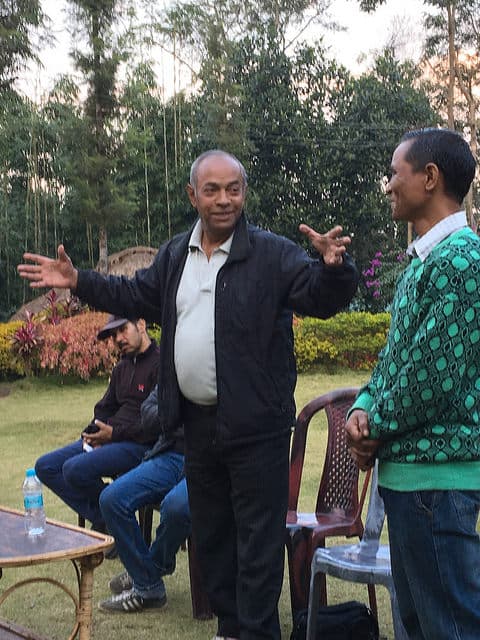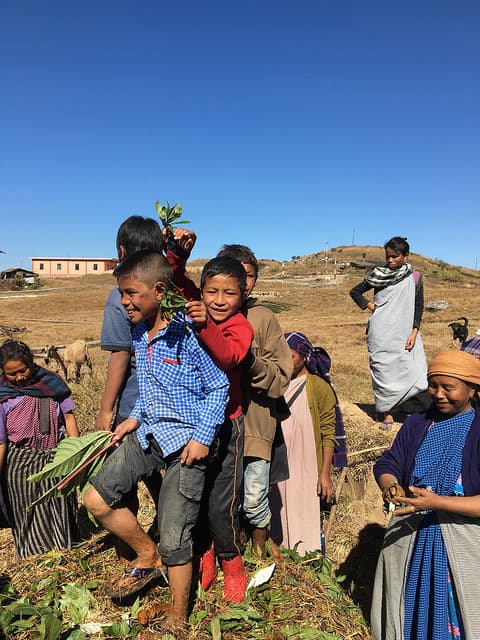Original article published in Food Tank
Article by Daniel Moss: Daniel Moss is the Executive Director of the AgroEcology Fund. He writes on food, water, and human rights topics for National Geographic, Huffington Post, and other media outlets.

Dr. Carl Rangad was something of a lone wolf among agronomists and scientists before finding a home within the North East Slow Food & Agrobiodiversity Society (NESFAS). Although trained in mycology and plant pathology, he stumbled upon his true passion in his father’s library, through a book describing a composting technique perfected by Jean Pain for cooking down saplings, branches, and underbrush into a rich heap of composted, natural fertilizer. Carl was fascinated with the idea of increasing soil fertility by composting—it was much kinder to farmers’ wallets and depleted soils.
How to get his fellow agronomists in the Indian government to embrace agroecological techniques was another story. Accustomed to improving crop yields with chemical fertilizers and pesticides, eager ears were few. He persisted. During 31 years of public service, the government mostly put up with him, and occasionally permitted him to design and implement soil conservation and agro-biodiversity programs that understood agriculture not as process of mining soil fertility, but adding to it.

Carl’s home is in Shillong, in a tribal region of North East India, sandwiched between Bhutan, Bangladesh and Burma. Outside of Shillong, by a sacred forest, we looked over paddy fields that Carl had sought to restore through a government watershed development program. Down in the valley, Carl pointed to evidence of soil conservation – fruit orchards and live bamboo fencing. “It didn’t always work out as I would have wished,” he said, “but I wanted to show you this. When I look at this valley, I have to admit to feeling somewhat nostalgic and proud.” Below a band of forest, a lazy stream meandered through the paddies, draining finally to the Bay of Bengal.
Since Carl retired from the Department of Agriculture four years ago, he has focused all his efforts on agrobiodiversity and indigenous issues. The indigenous communities, he explained, are front-line protectors of biodiversity. The hillside on which we stood was the western edge of the fairgrounds of the Indigenous Terra Madre, a global gathering organized by Carl and his team. It was held in 2015 with 70,000 people, including 169 indigenous communities from seven continents. The event was a huge success even as the complex logistics nearly killed them physically and financially. The event struck a chord among advocates across the world seeking to build – or rebuild – fair and sustainable food systems based on ancestral wisdom.
“Modern” food systems haven’t worked so well in India– hundreds of thousands of indebted farmers have committed suicide since the start of the “green revolution”. While the global industrial food system narrows diets to fewer crops extracted from bigger factory farms on unhealthier soils, the Indigenous Terra Madre celebrated the food systems of not only the Khasi (the tribe to which Carl belongs) but indigenous peoples around the world. Their traditions of seed saving and crop diversity are hedges against too much or too little rain – trends likely to worsen as climate change turns weather topsy turvy. Their practices reduce risks of malnutrition and market uncertainties.
While markets generally haven’t been kind to indigenous small farmers, NESFAS is not anti-market. Although the communities with which NESFAS works grow most of the food they eat and forage in the forest for medicines – one villager showed me the herbal equivalent of Viagra – there are school fees to pay, salt, sugar and oil to purchase. During the week I traveled with Carl and his colleagues to Khasi, Jaintia and Garo communities, we needled shy teens to imagine their future. NESFAS’ drive to preserve ancestral traditions only works if the next generation takes interest. How do the youth reconcile their attachment to their families and villages and traditional foods with the draw to towns and cities and Kentucky Fried Chicken?
In Laitsohpliah, a village where the village council has pledged a sizeable plot of land to NESFAS for an agroecology school, 20 year old Bakmenlang Nongrum isn’t doing too badly. He has an enviable harvest of peas, rice and radish. He and a stout schoolteacher led a composting party on a heap of grasses and manure. Kids hooted, sang and stomped. Traditional Khasi agriculture is slash and burn, with a long fallow period after harvest to restore soil fertility. Due to a growing population, farmers’ plots are shrinking. Pressures mount to keep the land producing. The composting practices introduced by Carl and his team are essential for the long-term well-being of the communities and the landscape.
It’s not easy to find young people willing to spend hot days bent over in the fields and cold nights huddled at home. Bakmenlang seems the exception. When teens leave to study high school, they taste urban life. Many stay on, except for the youngest girl who takes care of her parents – Khasi communities are matrilineal, with the ancestral lands being under the custody of the youngest girl. At four years old, NESFAS is just beginning to bridge the villagers’ agricultural talents with urban consumers’ growing interest in healthy, local foods. To sustain their operations, NESFAS is sketching plans for a business and brand that sells farmers’ organic rice, millet, tubers and vegetables. Shillong, with a population of nearly half a million, remains devoid of supermarket chains. That consumers aren’t yet buying from far-flung suppliers is a big advantage for fortifying local links to the region’s small farmers.

With NESFAS’ support, farmers are forming Participatory Guarantee System groups to assure quality. Having seen how the third party certification can exclude small producers, the International Federation of Organic Agriculture Movements (IFOAM) and some Indian state governments, including Meghalaya, now recognize this grassroots form of self-certification. A roadside stand that Carl helped start while serving in the Ministry draws urbanites interested in good quality vegetables.
As important as markets are, so is stopping land degradation, landlessness and land grabbing. Carl winced when we passed a smoking brick kiln that steals fertile topsoil for construction material. “Who gave them permission to put it there?” Carl laments the corruption, the sly deals that village councils strike with miners. “Sometimes I don’t feel so democratic. I want to just put a stop to this. Now.” We passed coal caves catacombs at roadside turnouts; black heaps spilled onto the road. The Public Works department buys gravel from aproned women who drive hammers into boulders. The greenery of the paddy fields is deceiving; prime farm country is being strip-mined.
Carl has seen government schemes sputter and pervert – it drives him nutty that most afforestation programs are done with pine, which not only aren’t native but undermine soil health and biodiversity. Carl admits to having been part of the problem, hooking farmers on subsidy-induced practices often abandoned when the subsidy ended. Despite misgivings, those watershed, afforestation and soil conservation programs have the potential for a reach and impact that NESFAS can only dream of. Carl’s contacts in public agencies are not yet cold; NESFAS collaborates with any and all to build a fair and sustainable food system.
Carl has a passionate team of young people as his colleagues– principally from the Khasi community. He insists on horizontal leadership, which is no simple thing when yielding to one’s elders is the cultural norm. He is 63 while they are in their twenties. They show him immense respect, calling him Sir – or Bah – Carl. I watched one young colleague – who described Carl as a father figure – pat his back through a coughing fit and later debate him on strategy. The team is grounded in community organizing – there is no skill that Carl wishes to impart more than listening to, and affirming, villagers’ ideas and leadership.
While Carl seeks to restore pride and practices in the Khasi hills, he knows it must be more than cultural restoration. The world has changed too much – population pressures on the land are too great, families’ cash needs too many, the web of intermediaries in the supply chain too complex. He is opposed to genetically-modified seeds and skeptical of many hybrid varieties but welcomes collaboration with scientists, economists and government. Doses of “modern” knowledge and new alliances – chosen selectively and converged with indigenous wisdom – will help craft the new sustainability.
Northeast India’ is a biodiversity hotspot; in fact, Carl serves as technical advisor to the state of Meghalaya’s Biodiversity Board. Their mission is to catalogue the cornucopia and publish it as a guide for land use planning. Elephants and leopards still roam in the rolling hills of forest; indigenous culture is strong, community ties relatively intact. Domino Pizzas are few; the economy is still largely Indian, if not local. If there’s somewhere on earth that a community food system based on agroecology can withstand global forces – and cut a path out of the food mess humanity is mired in – it’s here in India’s tribal Northeast with Carl and NESFAS’ support.
 Translate
Translate




